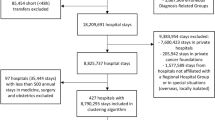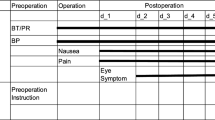Abstract
As the healthcare industry continues to generate a massive amount of medical data, healthcare organizations integrate data-driven insights into their clinical and operational processes to enhance the quality of healthcare services. Our preliminary hospital clustering analysis (Albarakati and Obradovic, in The IEEE 29th international symposium on computer-based medical systems (CBMS), IEEE, 2017) studied hospitals monthly admission behavior for different diseases. Results showed consistent behavior when disease symptoms similarity is considered. This study extends our preliminary work to include other aspects of disease data and the fusion of different views of disease data. It is an original approach that tackles clustering complex networks using a combination of multi-view and multi-domain clustering models while imposing data on the clustering goal from both medical and non-medical domains simultaneously. The objective of the study is to determine the effect of disease networks on characterizing the underlying clustering structure of 145 disease-specific hospital networks, each consisting of up to 152 hospitals. This is achieved by extracting two different views of disease networks. One disease network view based on similarity of symptom profiles was extracted from a 20 million medical bibliographic literature records. Another disease network view based on monthly hospitalization distribution was extracted from over 7 million discharge records data obtained from the California State Inpatient Database for years 2009–2011. Patient admission records included both medical and sociodemographic information. These multiple views were analyzed separately and were also integrated in a joint model that combined the two views. It is shown that the fusion of multi-view disease networks of monthly hospitalization distributions explained the hidden common structure shared among multiple hospital-specific disease networks. The group homogeneity measures for obtained hospital clusters ranged between 33 and 60% with average close to 50%. However, integrating multiple views of disease networks extracted from different domains, i.e., from literature and medical databases, better revealed the underlying clustering structure of disease-specific hospital networks. The group homogeneity measures for this multi-domain setting ranged between 38 and 76% with average close to 60%.








Similar content being viewed by others
References
Albarakati, N., Obradovic, Z.: Disease-based clustering of hospital admission: disease network of hospital networks approach. In: The IEEE 29th International Symposium on Computer Based Medical Systems (CBMS). IEEE (2017)
Belciug, S., Gorunescu, F.: Improving hospital bed occupancy and resource utilization through queuing modeling and evolutionary computation. J. Biomed. Inform. 53, 261–269 (2015)
Bourgeois, F.T., Monuteaux, M.C., Stack, A.M., Neuman, M.I.: Variation in emergency department admission rates in us children’s hospitals. Pediatrics 134(3), 539–545 (2014)
Delamater, P.L., Shortridge, A.M., Messina, J.P.: Regional health care planning: a methodology to cluster facilities using community utilization patterns. BMC Health Serv. Res. 13(1), 333 (2013)
Glass, J., Ghalwash, M.F., Vukicevic, M., Obradovic, Z.: Extending the modelling capacity of Gaussian conditional random fields while learning faster. In: AAAI, pp. 1596–1602 (2016)
Gligorijevic, V., Panagakis, Y., Zafeiriou, S.: Non-negative matrix factorizations for multiplex network analysis. arXiv:1612.00750 (2016)
Groves, P., Kayyali, B., Knott, D., Van Kuiken, S.: The big data revolution in healthcare: accelerating value and innovation. McKinsey Q. 2, 3 (2013)
Khojah, I., Li, S., Luo, Q., Davis, G., Galarraga, J.E., Granovsky, M., Litvak, O., Davis, S., Shesser, R., Pines, J.M.: The relative contribution of provider and ED-level factors to variation among the top 15 reasons for ED admission. Am. J. Emerg. Med. 35(9), 1291–1297 (2017). https://doi.org/10.1016/j.ajem.2017.03.074
Kivelä, M., Arenas, A., Barthelemy, M., Gleeson, J.P., Moreno, Y., Porter, M.A.: Multilayer networks. J. Complex Netw. 2(3), 203–271 (2014)
McMahon Jr., L.F., Wolfe, R.A., Tedeschi, P.J.: Variation in hospital admissions among small areas: a comparison of Maine and Michigan. Med. Care 27, 623–631 (1989)
Moni, M.A., Liò, P.: Network-based analysis of comorbidities risk during an infection: SARS and HIV case studies. BMC Bioinform. 15(1), 333 (2014)
Ni, J., Tong, H., Fan, W., Zhang, X.: Inside the atoms: ranking on a network of networks. In: Proceedings of the 20th SIGKDD International Conference on Knowledge Discovery and Data Mining, pp. 1356–1365. ACM (2014)
Ni, J., Tong, H., Fan, W., Zhang, X.: Flexible and robust multi-network clustering. In: Proceedings of the 21st SIGKDD International Conference on Knowledge Discovery and Data Mining, pp. 835–844. ACM (2015)
Phillip, P.J., Mullner, R., Andes, S.: Toward a better understanding of hospital occupancy rates. Health Care Financ. Rev. 5(4), 53 (1984)
Raghupathi, W., Raghupathi, V.: Big data analytics in healthcare: promise and potential. Health Inf. Sci. Syst. 2(1), 3 (2014)
Reid, F.D., Cook, D.G., Majeed, A.: Explaining variation in hospital admission rates between general practices: cross sectional study. BMJ 319(7202), 98–103 (1999)
Sabbatini, A.K., Nallamothu, B.K., Kocher, K.E.: Reducing variation in hospital admissions from the emergency department for low-mortality conditions may produce savings. Health Aff. 33(9), 1655–1663 (2014)
Shay, P.D.: More ore than just hospitals: an examination of cluster components and configurations. Ph.D. dissertation, Health Services Organization and Research Department, Virginia Commonwealth University (2014)
Thomas, J.W., Griffith, J.R., Durance, P.: Defining hospital clusters and associated service communities in metropolitan areas. Socioecon. Plan. Sci. 15(2), 45–51 (1981)
Zhou, X., Menche, J., Barabási, A.L., Sharma, A.: Human symptoms-disease network. Nat. Commun. 5, 4212 (2014)
Acknowledgements
This research was supported in part by NSF BIGDATA Grant 14476570. Healthcare Cost and Utilization Project (HCUP), Agency for Healthcare Research and Quality, provided part of the data used in this study.
Author information
Authors and Affiliations
Corresponding author
Rights and permissions
About this article
Cite this article
Albarakati, N., Obradovic, Z. Multi-domain and multi-view networks model for clustering hospital admissions from the emergency department. Int J Data Sci Anal 8, 385–403 (2019). https://doi.org/10.1007/s41060-018-0147-5
Received:
Accepted:
Published:
Issue Date:
DOI: https://doi.org/10.1007/s41060-018-0147-5




